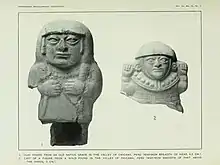Millenarianism in colonial societies
Millenarianism is the belief by a religious, social, or political group or movement in a coming fundamental transformation of society, after which "all things will be changed".[1] These movements have been especially common among people living under colonialism or other forces that disrupted previous social arrangements.
| Part of a series on |
| Anthropology of religion |
|---|
 |
| Social and cultural anthropology |
The phrase "millennialist movement" has been used by scholars in anthropology and history to describe the common features of these religious phenomena when viewed as social movements, and has most often been used to describe the social movements that have taken place in colonized societies.[2]
Christianity itself can be seen as originating in a millenarian movement among Jewish people living under Roman rule, although its characteristics as a social movement quickly changed as it spread through the Roman Empire. The Book of Revelation also predicts a thousand-year reign of Jesus prior to the defeat of Satan.
Some millenarian movements include:
- The Ghost Dance movement among Native Americans.
- Tenskwatawa the "Shawnee Prophet", who called for a return to ancestral ways and the defeat of European colonial power.
- The Xhosa cattle-killing movement of South Africa, led by the prophetess Nongqawuse.
- The Righteous Harmony Society during the Boxer Rebellion was a Chinese movement reacting against Western colonialism.
- The God Worshipping Society of the Taiping Rebellion, which fused Anglo-American Protestant Christian and Chinese elements into a movement that focused the resentment of Han Chinese against the ruling Manchu Qing Dynasty. Hong Xiuquan, their leader, proclaimed himself to be the second son of God and brother of Jesus Christ, as well as the Tian Zi (Son of Heaven), a sacred title of the Chinese emperor. He would establish the Taiping Heavenly Kingdom, which controlled much of southern China from 1851-1864.
- The Maji Maji Rebellion was influenced by an African spirit medium who gave his followers war medicine that he said would turn German bullets into water.
- Bábism and Baháʼísm, two perennialist movements founded in Qajar Persia by self-proclaimed prophets.
- The Mahdist State in Sudan, which was established by Muhammad Ahmad, who proclaimed himself the Mahdi and led a jihad against the Khedive of Egypt's rule over the Sudan and the British Empire.
- The Ahmadiyya movement, an Islamic messianic movement with millenarian elements, founded by Mirza Ghulam Ahmad (d.1908), who claimed to be the Mahdi and Messiah in British India during the late nineteenth century.[3]
- Chilembwe uprising - a 1915 uprising in Nyasaland led by a Baptist minister named John Chilembwe, with diverse social, political, and spiritual motivations that included some member with millenarian beliefs.
- The Melanesian John Frum cargo cult believed in a return of their ancestors brought by Western technology.
- Burkhanism was an Altayan movement led by a visionary that reacted against Russification.
- The Battle of Kuruyuki was the 1892 attempt of the Eastern Bolivian Guarani to combat Christianity and Bolivian settlers.
- The Guaycuruan-speaking Toba attempted to regain control of the Gran Chaco in Argentina in 1904.
- The Tepehuán Revolt in 1620s Mexico was an attempt to expel Spanish colonists and priests and return to traditional ways.
- The loss of king Sebastian of Portugal was not accepted by the Portuguese people. They believed that he would return to lead his kingdom. This Sebastianism was extended to Brazil where the establishment of the secular Republic of Brazil led many to belief Sebastian would re-appear to restore monarchy.
- A number of religious movements in the African diaspora -- for example, Haitian Vodou, Louisiana Voodoo, Santería, Candomblé, and Hoodoo -- syncretise Christian and traditional West African beliefs and practices, sometimes with influence from other traditions such as Native American religions, Islam, Spiritism, or Western esotericism. While these religions are not themselves especially millenarian, they would have a heavy influence on later religious movements in the African diaspora, such as Rastafarianism, the Nation of Islam, the Nuwaubian Nation, and the Black Hebrew Israelites which do have strong millenarian doctrines. These later movements also greatly emphasise black nationalist identity, present themselves as movements for political as well as spiritual liberation, have a history of encouraging black solidarity and political activism, and have variously been involved in political violence.
- Other religious movements in the African diaspora -- such as Ethiopianism (a movement among black Americans to adopt Ethiopian Christianity) or the American Society of Muslims (an organisation of black Sunni Muslims, in opposition to the Nation of Islam) may, like these millenarian new religious movements, share an emphasis on black identity, political activism, and community building, but they also emphasise the teachings of existing religions (Ethiopian Christianity and Sunni Islam, respectively), and so are not millennarian religions.
See also
References
- Baumgartner, Frederic J. 1999. Longing for the End: A History of Millennialism in Western Civilization, New York: Palgrave, pp 1-6
- Burridge, Kenelm (1969). New Heaven, New Earth: A study of Millenarian Activities. London: Basil Blackwell.
- Qasmi, Ali Usman (2015). The Ahmadis and the Politics of Religious Exclusion in Pakistan. Anthem Press. p. 36. ISBN 978-1-78308-425-8.